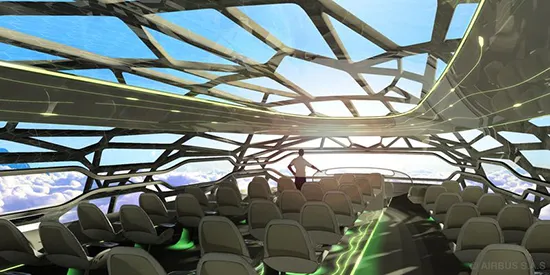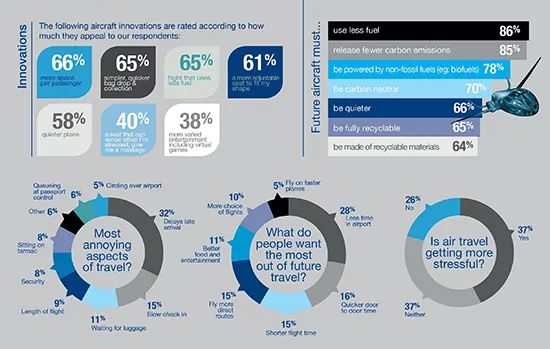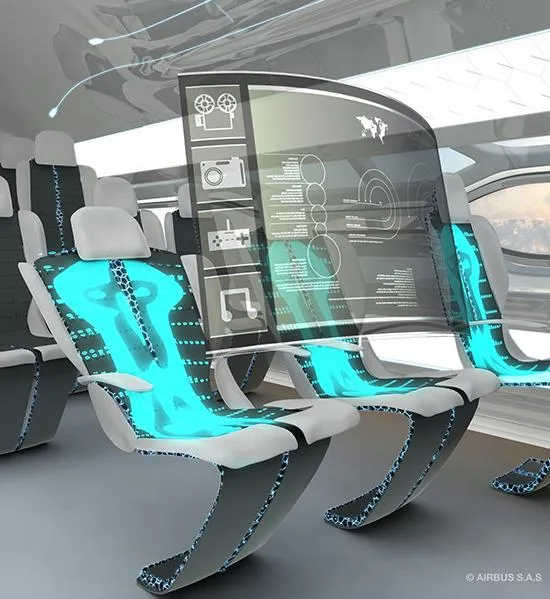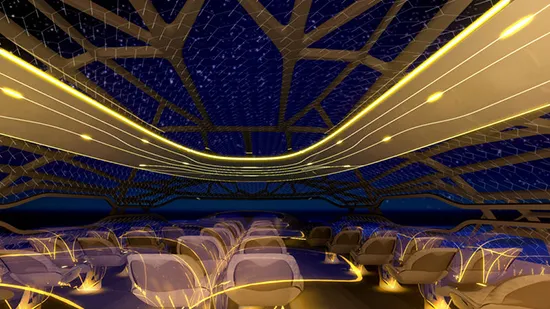Aircraft Design Inspired by Nature and Enabled by Tech
In 2050, Airbus hopes to fly you around in a see-through jet shaped like a bird skeleton, with morphing seats, spa treatments, and virtual entertainment
/https://tf-cmsv2-smithsonianmag-media.s3.amazonaws.com/filer/20120816102010conceptplane_1_470.jpg)
As if it weren’t already mind-bending enough to envision yourself hurtling through the skies in a metal canister at 500 miles per hour, now Airbus wants you to imagine your gravity-defying journey in an aircraft with transparent skin. Tapping into some of the most cutting-edge design thinking today, the aviation leader has developed a concept plane that is not intended for flight—at least not in this iteration—but is an innovation tool that “stretches the imagination of engineers, and…highlights some of the challenges and decisions that lie ahead for air travel.”
The concept plane, which they hope resembles the real Airbus models of 2050, takes biomimicry as a guiding principle for the design of forms and materials. The most noticeable aspect of this approach is in the fuselage, which, instead of being wrapped in opaque steel, is composed of a web-like network of structural material that looks a bit like a skeleton. In fact, that’s exactly what it should remind you of, because it’s inspired by the bone structure of birds.

In a presentation on the company’s future design plans, chief engineer Charles Champion explained, “Bone is both light and strong because its porous interior carries tension only where necessary, leaving space elsewhere.” The space between the so-called “bionic bones”of the plane become panoramic windows that wrap all the way around. “ou will be able see the pyramids or the Eiffel Tower through the transparent floor of the aircraft.”

While the structural design is inspired by creatures that have existed for millennia, many of the materials are produced using technology that as barely been known for a decade. 3D-printing is one of the techniques that may enable Airbus to create the precise, spare forms they require, first drafting them on a computer and then manufacturing them through rapid layering that builds up the design exactly as it’s intended, with no waste. For the cabin’s electrical system, Airbus intends to integrate a brain-like “network of intelligence” into the walls of the plane, which is responsive to interior climate conditions and passenger needs without requiring huge amounts of cable, wire and switches.

All of these strategies—the lightweight structure, waste-free manufacturing, and wireless electrical systems—can contribute to reductions in emissions and fuel use. The cumulative effect of using fewer resources for each plane could result in a massive overall improvement in aviation’s environmental impact. In that vein, the Airbus concept plane is one of the few instances (at least for now), where the term “organically grown” refers not to food, but to seating. The seats of the plane will potentially be composed of plant-based biomaterials which go a few leaps past memory foam toward smart materials that form to and remember the body’s optimal position.

Of course all of the aspects of physical comfort and wellness that currently elude passengers will find their way into this in-flight experience, too, in the form of interactive zones, where travelers can socialize, play games, exercise and enjoy various holistic treatments like massage and aromatherapy. It’s almost enough to make you forget you’re trapped inside a pressurized container six vertical miles above your home planet.
/https://tf-cmsv2-smithsonianmag-media.s3.amazonaws.com/accounts/headshot/sarah-rich-240.jpg)
/https://tf-cmsv2-smithsonianmag-media.s3.amazonaws.com/accounts/headshot/sarah-rich-240.jpg)